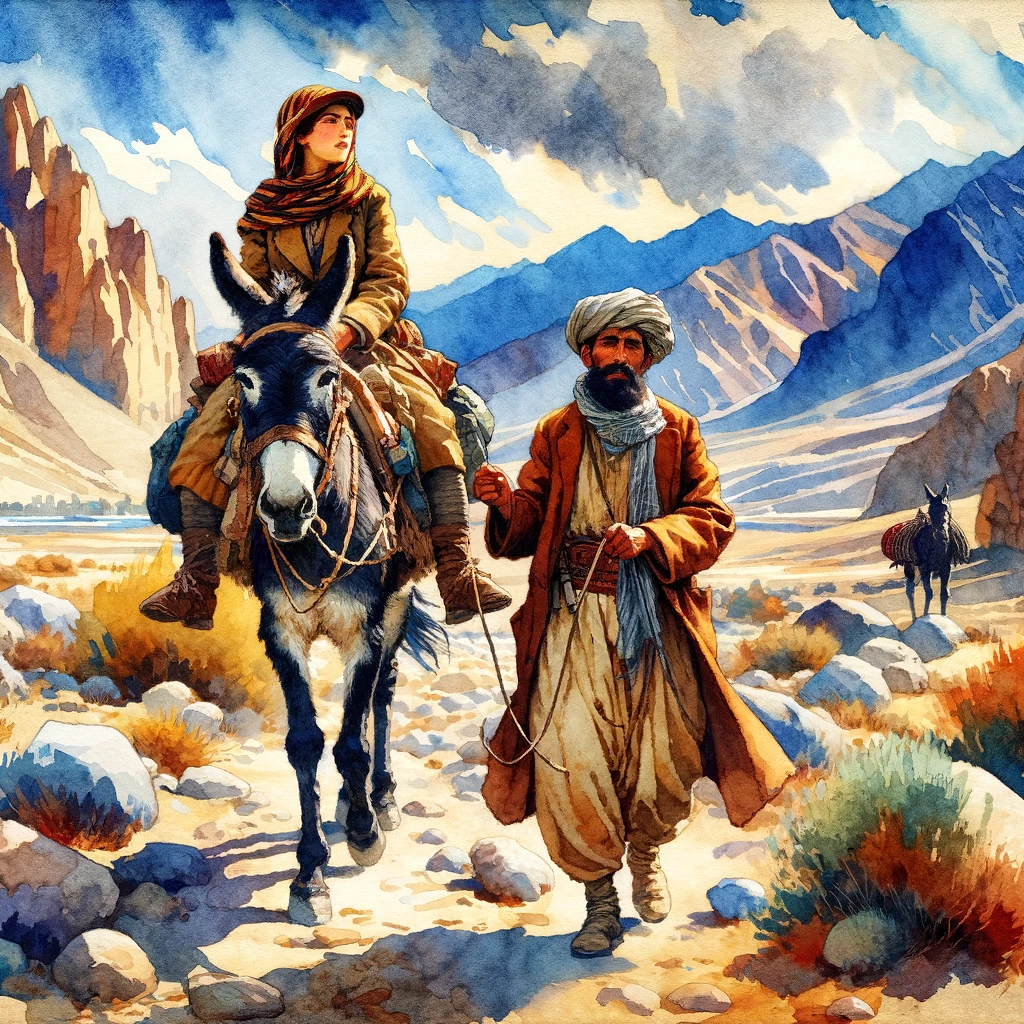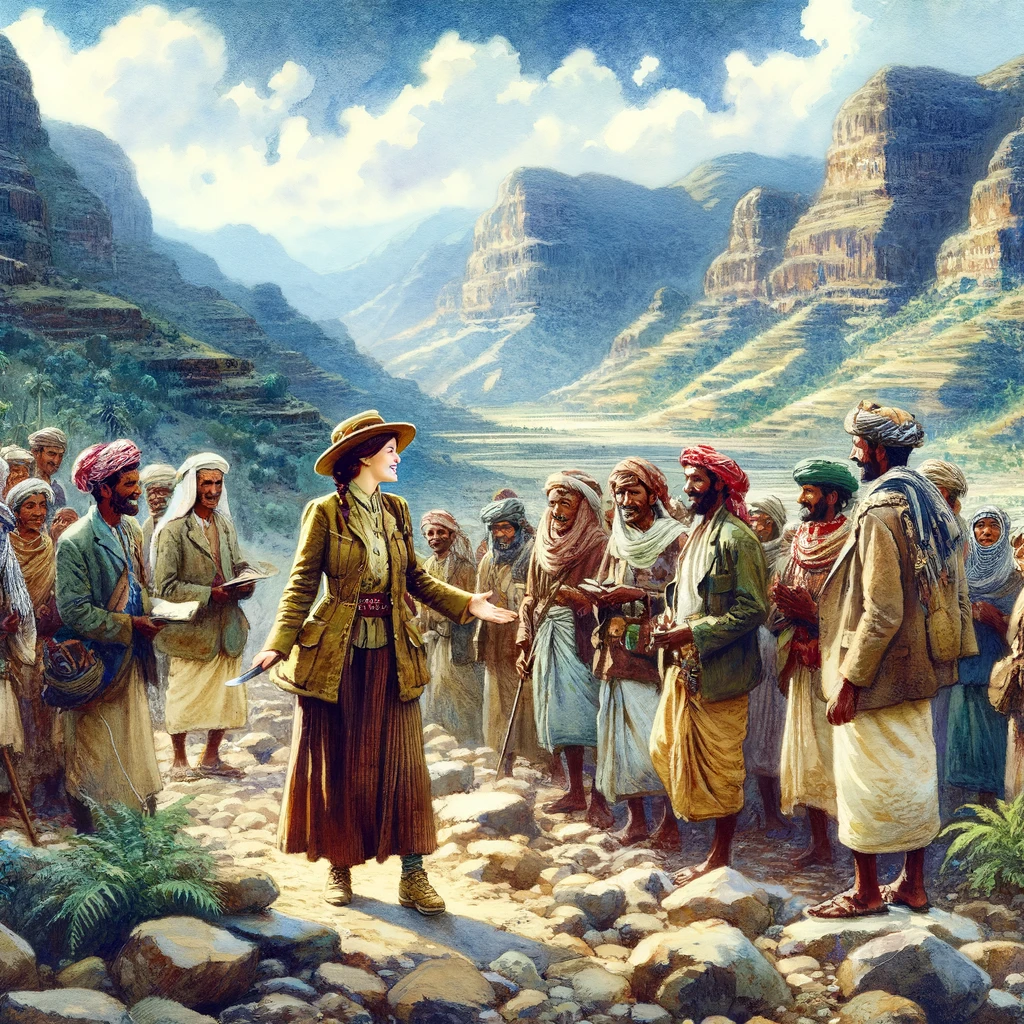Freya Stark stands as a luminary in the realm of exploration and travel literature, marking her presence as a pioneering female explorer whose contributions have left an indelible mark on the 20th century. Renowned for her vivid descriptions and profound personal insights, Stark’s narratives transcend mere travelogues, weaving together the fabric of the lands she traversed with the threads of her own experiences and reflections. Her journeys, daring and uncharted, spanned across the vast and variegated landscapes of the Middle East, the enigmatic terrains of Yemen, the historic depths of Syria, the rugged beauty of Turkey, and the mysterious reaches of Afghanistan. Each region, with its unique culture, history, and landscape, served as a canvas for Stark’s eloquent prose and keen observations.
Stark’s writings offer a window into the soul of these regions, capturing the essence of their people, their traditions, and their historical significance with an intimacy and fidelity that few have managed to achieve. Her work does not merely chronicle her physical journeys but delves deeper into the spirit of the places she visited, reflecting a profound engagement with her surroundings that is both enlightening and inspirational. By doing so, Stark not only documented her extraordinary journeys but also provided unique insights into the cultures, histories, and landscapes of these regions, effectively bridging the gap between Western perceptions and Eastern realities.
List of Freya Stark’s Books In Order of Publication Date
- Valley of the Assassins: and Other Persian Travels (1934)
- The Southern Gates of Arabia: A Journey in the Hadhramaut (1936)
- Seen In The Hadhramaut (1938)
- A Winter in Arabia: A Journey Through Yemen (1940)
- Letters from Syria (1942)
- East is West (1945)
- Perseus in the Wind: A Life of Travel (1948)
- Traveller’s Prelude (1950)
- Beyond Euphrates. Autobiography 1928-1933 (1951)
- The Coast of Incense: Autobiography 1933-1939 (1953)
- Ionia, a Quest (1954)
- The Lycian Shore (1956)
- Alexander’s Path: From Caria to Cilicia (1958)
- Riding to the Tigris (1959)
- The Journey’s Echo: Selected Travel Writings (1963)
- The Minaret of Djam: An Excursion in Afghanistan (1970)
- A Winter in Nepal (1972)
- The Islands of the Blessed (1977)
- A Peak in Darien (1976)
- The Zodiac Arch (1981)
Freya Stark’s Iran Books
The opening chapter of Freya Stark’s extraordinary journey into the Middle East is marked by her profound exploration of Iran, a country rich in ancient traditions and cultural heritage. Stark’s work in this region showcases not only her fearless spirit of adventure but also her deep appreciation and nuanced understanding of the complexities of the places she visited.
The Valleys of the Assassins and Other Persian Travels (1934)
In this landmark publication, Stark recounts her audacious travels into the remote regions of the Elburz Mountains, where she sought to uncover the mysteries surrounding the legendary Assassins. Published in 1934, this narrative transcends mere adventure, providing a detailed exploration of the historical significance of the Assassins, intertwined with Stark’s own encounters and observations of the local populations’ lives and customs. Her work here is distinguished by its rich descriptive power and the keen insights it offers into a part of the world that was, at the time, largely unknown to the outside world.

Persian Pictures (1930)
This earlier work, published in 1930, presents a poetic and intimate portrayal of Persia before Stark’s more famous explorations. Through a series of evocative essays and sketches, Stark reflects on the beauty and complexity of the Iranian landscape and culture. “Persian Pictures” offers readers a glimpse into Stark’s initial impressions and experiences in Iran, showcasing her ability to capture the essence of her surroundings with profound sensitivity and clarity. This collection stands as a testament to Stark’s early fascination with the Middle East and her remarkable talent for bringing its stories to life through her words.
Freya Stark’s Yemen Books
Freya Stark’s literary journey takes a fascinating turn with her exploration of Yemen, a country characterized by its dramatic landscapes and rich historical heritage. Stark’s writings on Yemen not only document her physical journey through this rugged terrain but also provide a deep insight into the cultural and architectural splendors of the region.
The Southern Gates of Arabia: A Journey in the Hadhramaut (1936)
This book chronicles Stark’s groundbreaking expedition to the Hadhramaut Valley, one of Yemen’s most remote and inaccessible areas. Published in 1936, it narrates her bold journey, detailing her interactions with local tribes, and her observations of the ancient architecture that dots this secluded part of Arabia. Stark’s narrative skillfully combines adventure with scholarly inquiry, shedding light on the customs, traditions, and architectural marvels of the Hadhramaut, thus offering readers a rare glimpse into a world that was, at the time, largely unknown to the West.
Seen In The Hadhramaut
Building upon her initial explorations, this work delves deeper into Stark’s experiences in Yemen, focusing more intently on the architectural beauty and historical significance of the region. While the exact publication date blends into her continuous stream of works on the Middle East, this volume stands as a testament to her enduring fascination with Yemen’s ancient heritage, showcasing her meticulous attention to detail and her profound appreciation for the area’s unique cultural landscape.

A Winter in Arabia: A Journey Through Yemen (1940)
In this captivating account of her winter expedition through Yemen, published in 1940, Stark paints a vivid picture of her journey across the country’s varied landscapes. From the bustling markets of Sana’a to the remote mountain villages, Stark’s narrative highlights her encounters with local societies and their ancient traditions. Her observations offer an unparalleled insight into the daily lives and customs of the Yemeni people, framed against the backdrop of the country’s stunning architectural and natural wonders. “A Winter in Arabia” is not only a travelogue but a profound exploration of Yemen’s cultural and historical depth, as experienced and recorded by one of the 20th century’s most intrepid explorers.

Freya Stark’s Syria Books
Freya Stark’s engagement with the Middle East extends into the captivating landscapes and rich historical tapestry of Syria. Her contributions to the understanding and appreciation of this region are encapsulated in her unique epistolary work.
Letters from Syria (1942)
This collection, published in 1942, offers a deeply personal and immediate glimpse into Stark’s journey through Syria. Through a series of letters written during her travels, Stark conveys the vibrancy of Syrian life, the beauty of its landscapes, and the profound historical significance embedded within its cities and ruins. Unlike traditional travel narratives, this compilation allows readers to see the country through Stark’s eyes, as she experiences it in real-time. The letters are rich with observations and reflections on the cultural interactions, societal norms, and architectural wonders of Syria, providing a multifaceted view of the country during a pivotal period. “Letters from Syria” stands as a testament to Stark’s ability to capture the essence of her surroundings, offering invaluable insights into the cultural and historical landscapes of Syria through her eloquent and insightful prose.
General Middle Eastern Travels
Freya Stark’s contributions to travel literature extend beyond her detailed accounts of specific regions, offering broader insights into the Middle East as a whole. Her works in this category reflect her versatility as a traveler and her profound engagement with the myriad cultures she encountered.
East is West
This work provides a panoramic view of Stark’s extensive travels across the Middle East, from the bustling bazaars of Baghdad to the ancient ruins of Palmyra. Through her vivid narratives, Stark showcases her adaptability as a traveler and her deep respect and curiosity for the cultures she immerses herself in. Her ability to traverse both the physical and cultural landscapes of the Middle East, documenting her experiences with keen observation and empathy, makes this work a significant contribution to the understanding of this complex region.
The Coast of Incense: Autobiography 1933-1939
In this autobiographical work, Stark reflects on her adventurous travels across the Arabian Peninsula and the Near East during the mid-1930s. Offering both personal and historical insights, she narrates her experiences with the people she meets, the landscapes she navigates, and the historical sites she explores. Through her journey, Stark provides a window into the soul of Arabia and its surrounding regions, highlighting the rich cultural tapestry and historical depth that define these areas. Her writing not only captures the essence of her adventures but also contributes to a deeper understanding of the historical and cultural dynamics at play.
Rome on the Euphrates: The Story of a Frontier
Published in 1966, this work explores the significant historical interactions between Rome and the Middle East, delving into the cultural and political exchanges that shaped the frontier between these civilizations. Stark’s examination of this historical relationship is thorough and insightful, drawing on a wide range of sources to illuminate the complexities of this cross-cultural encounter. Her analysis reveals the lasting influence of Roman civilization on the Middle East and vice versa, providing readers with a comprehensive understanding of the enduring legacies that these interactions have left on the region. “Rome on the Euphrates” stands as a testament to Stark’s scholarship and her ability to bring historical narratives to life through her engaging writing style.
Freya Stark’s Books About Turkey
Freya Stark’s literary journey also encompassed the historic and picturesque landscapes of Turkey, tracing the remnants of ancient civilizations and immersing herself in the rich tapestry of Anatolian culture. Her work in Turkey is characterized by a harmonious blend of historical exploration, archaeological interest, and personal travel anecdotes, which together provide a comprehensive and vivid portrayal of the region.
Alexander’s Path: From Caria to Cilicia (1958)
In this engaging narrative, Stark retraces the steps of Alexander the Great, from Caria to Cilicia, intertwining her personal travel experiences with historical insights. Published in 1958, the book is a testament to Stark’s skill in navigating the rich historical landscapes of Turkey, bringing to life the ancient paths trodden by one of history’s most iconic figures. Her journey not only illuminates the historical significance of Alexander’s conquests but also reflects on the enduring legacy of these ancient lands, blending the past with her contemporary adventures to create a rich, layered narrative.
The Lycian Shore (1956)
Stark’s exploration of the Lycian coast offers readers a glimpse into one of Turkey’s most stunning regions, known for its rugged landscapes and ancient ruins. Published in 1956, this work delves into the history and beauty of Lycia, with Stark’s descriptive prowess painting a vivid picture of the coastal vistas and archaeological treasures. Her narrative is both informative and personal, providing insights into the region’s past while capturing the enchantment of its present state.

Ionia, a Quest (1954)
This book documents Stark’s extensive exploration of the ancient cities of Ionia, blending archaeology, history, and personal travel narrative. Published in 1954, “Ionia, a Quest” is a reflective and meticulously researched journey through the ruins and remnants of one of history’s most influential civilizations. Stark’s fascination with the Ionian cities is evident in her detailed observations and the connections she draws between the past and her own experiences, offering a unique perspective on the cultural and historical landscapes of Turkey.
Through these works, Freya Stark not only contributes to the broader understanding of Turkey’s historical significance but also shares her personal journey of discovery, highlighting the country’s natural beauty, its ancient heritage, and the vibrant tapestry of life that continues to thrive within its borders. Her narratives on Turkey stand as enduring contributions to travel literature, captivating readers with their blend of historical depth, archaeological interest, and the allure of adventure.

Adventures in Afghanistan
In her foray into the rugged terrains of Afghanistan, Freya Stark’s intrepid spirit and thirst for understanding the unknown led her to one of the country’s most enigmatic and less-traversed landmarks. Her adventures in Afghanistan are encapsulated in a work that not only highlights her bold exploratory nature but also offers insightful reflections on the cultural and historical essence of this fascinating region.
The Minaret of Djam: An Excursion in Afghanistan (1970)
This book documents Stark’s journey to the Minaret of Jam, a towering structure standing remote and solitary in the Afghan landscape, which remains one of the most significant and mysterious artifacts of the Islamic world. Published in 1970, Stark’s narrative provides readers with a rare and captivating glimpse into the landscape, culture, and historical context of Afghanistan during a period of relative obscurity to the outside world. Her journey to the Minaret of Jam is not just a physical traverse across the rugged Afghan terrains but also a deep dive into the rich tapestry of history and culture that defines the region. Stark’s account is replete with observations on the architectural splendor of the Minaret, the challenges of travel in such a remote area, and the interactions with local Afghans that provided depth and nuance to her understanding of the country. Through her unique blend of adventurous spirit, scholarly insight, and empathetic engagement with local cultures, Stark offers a narrative that is both enlightening and enthralling, inviting readers to share in her fascination and respect for Afghanistan’s complex history and heritage.
Stark’s exploration in Afghanistan, particularly her visit to the Minaret of Jam, stands as a testament to her undaunted curiosity and commitment to documenting the world’s hidden wonders. Her work not only enriches our understanding of Afghanistan’s historical landmarks but also serves as a bridge connecting readers with the profound beauty and cultural richness of a region often overshadowed by its geopolitical struggles. Through her eyes, we are afforded a glimpse into the soul of Afghanistan, marked by its enduring legacy and the timeless allure of its landscapes and people.
Philosophical and Reflective Works
Freya Stark’s literary oeuvre is not limited to the mere documentation of her travels; it encompasses a profound philosophical and reflective dimension that offers insights into her worldview, her understanding of human nature, and the essence of exploration itself. Her works in this category transcend the physical landscapes she traversed, venturing into the terrains of the mind and spirit.
Perseus in the Wind (1948)
In this contemplative work, Stark shares her reflections on her travels and the philosophical lessons gleaned from her experiences. Published in 1948, the book serves as a meditation on the nature of discovery, the joy of solitude, and the beauty found in the unexpected corners of the world. Stark’s introspective narrative invites readers to ponder the deeper meanings of travel and the transformative power it holds over the traveler’s soul. Her eloquent prose and insightful observations provide a window into her own journey of self-discovery, influenced by the myriad cultures and landscapes she encountered.
The Journey’s Echo (1963)
This collection of essays and reflections delves into the core of Stark’s travel ethos, exploring the intrinsic value of exploration and the insights it provides into the human condition. Published in 1963, the work compiles Stark’s thoughts on a wide range of subjects, from the nuances of cultural encounters to the personal revelations that travel elicits. Through her reflective writing, Stark articulates the enduring allure of the unknown and the ceaseless quest for knowledge that drives adventurers forward.
A Peak in Darien (1976)
Stark muses on the concept of exploration, both in its literal sense and as a metaphor for intellectual and spiritual inquiry. Published in 1976, this work discusses the human drive for discovery and the quest for understanding that propels us beyond our boundaries. Drawing on her extensive travels and the historical figures that inspired her, Stark explores the motivations behind exploration and its significance in expanding the horizons of the human experience.
The Zodiac Arch (1988)
In one of her later works, Stark offers further reflections on her life and travels, intertwining personal insights with broader philosophical themes. Published in 1988, the book weaves together the various strands of Stark’s experiences, beliefs, and observations into a cohesive narrative that highlights her intellectual depth and her profound engagement with the world. Through her reflections, Stark addresses themes of identity, the passage of time, and the interconnectedness of humanity, providing a thoughtful and engaging exploration of the life of an explorer.
Together, these philosophical and reflective works encapsulate Freya Stark’s enduring legacy as a thinker and a traveler. They offer readers not only a glimpse into the mind of one of the 20th century’s most intrepid explorers but also an invitation to reflect on their own journeys and the deeper meanings that travel can uncover. Stark’s writings in this category are a testament to her belief in the transformative power of exploration, both of the world and of oneself.
Autobiographical Works
Freya Stark’s autobiographical works provide a more intimate look into the life of one of the most celebrated female explorers and travel writers of the twentieth century. These writings not only chronicle her physical journeys but also map the internal landscapes of her desires, fears, and the genesis of her insatiable curiosity about the world. Through her autobiographies, Stark allows readers to understand the personal motivations and experiences that shaped her path as an explorer and writer.
Traveller’s Prelude (1950)
This volume serves as an autobiographical account of Stark’s early life, tracing the origins of her passion for travel and exploration. Published in 1950, “Traveller’s Prelude” offers insights into the formative years of Stark’s life, including her upbringing, education, and the early travels that ignited her lifelong love affair with the Middle East. The book is a deeply personal narrative that explores the development of Stark’s character and her early dreams of adventure, providing a foundation for understanding the motivations behind her later travels and writings. Stark’s reflections on her youth and the challenges she overcame to pursue her dreams of exploration are both inspiring and poignant, offering a glimpse into the making of a trailblazer.
Beyond Euphrates. Autobiography 1928-1933 (1951)
Continuing from where “Traveller’s Prelude” left off, “Beyond Euphrates” delves into Stark’s extensive travels in the Middle East between 1928 and 1933. Published a year after “Traveller’s Prelude,” this volume chronicles her adventures and the personal and historical discoveries made during her early explorations in the region. Stark’s narrative is rich with descriptions of the landscapes, people, and cultures she encountered, set against the backdrop of her own journey of self-discovery. “Beyond Euphrates” not only documents Stark’s travels but also reflects on the broader historical and political context of the Middle East during this period, showcasing her keen observational skills and deep understanding of the region. Through her autobiographical writings, Stark provides a compelling account of her transformation from a curious traveler to a seasoned explorer and respected author, offering invaluable insights into the experiences that shaped her legacy.
Together, these autobiographical works paint a comprehensive portrait of Freya Stark, from her early influences and initial steps into the unknown to the culmination of her first significant explorations in the Middle East. They not only chronicle the external journeys she undertook but also the internal journey of growth, discovery, and the relentless pursuit of knowledge that defined her life. Through “Traveller’s Prelude” and “Beyond Euphrates,” readers are invited to journey alongside Stark, experiencing the world through her eyes and understanding the profound impact that travel had on her life and work.
Conclusion
Freya Stark’s indelible mark on travel literature and cultural understanding is a testament to her life’s work as an explorer, writer, and bridge-builder between cultures. Her detailed and empathetic portrayals of the regions she explored have significantly contributed to diminishing cultural divides, offering her readers a lens through which to view the world with greater nuance and appreciation. Stark’s narratives are characterized by a deep respect for the people and places she encountered, highlighting her role not just as an observer but as a participant in the cultural tapestries she sought to understand.
In today’s globalized world, where the interconnection of cultures and communities is ever more apparent, the relevance of Stark’s work continues to resonate. Her writings serve as a reminder of the importance of approaching the unknown with openness, curiosity, and a willingness to learn. Stark’s journeys through the Middle East, Turkey, Afghanistan, and other regions provide valuable insights into the complexities and beauties of these areas, challenging stereotypes and encouraging a more informed and compassionate understanding of the world.
The legacy of Freya Stark transcends the era in which she lived, cementing her status as a timeless voice in the realm of exploration and cultural exchange. Through her prolific output of travel literature, she not only documented her extraordinary journeys but also shared the profound philosophical and reflective insights she gained along the way. Stark’s life and work inspire future generations of explorers, writers, and readers to venture beyond their own boundaries, both geographical and intellectual, in pursuit of a deeper connection with the diverse cultures that compose our global community.

